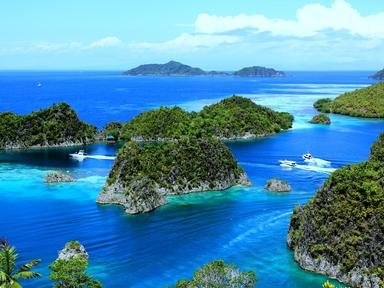Quiz Answer Key and Fun Facts
1. The island of New Guinea is one of the largest islands on earth that is not a continent. It is officially classed in what position with respect to overall area?
2. New Guinea was colonised by a number of different European nations in the 19th century. During the period immediately before World War I, which were the main colonial powers controlling the New Guinea mainland and surrounding major islands?
3. Approximately how many languages are spoken in the island of New Guinea today?
4. Though generally considered as a tropical island, New Guinea has several mountain ranges as well. The highest mountain in New Guinea is Puncak Jaya, in the Indonesian half of the island. The approximate elevation of Puncak Jaya is:
5. New Guinea is located in the western Pacific Ocean and shares social and cultural characteristics with a number of islands in its vicinity. Along with the Solomon Islands, Vanuatu, Fiji, New Caledonia and associated islands, New Guinea is considered to be a part of what subregion of Oceania?
6. New Guinea is surrounded by a number of islands which, while not as massive as the main island, are nonetheless substantial islands on their own. One of these islands is New Britain. Though dwarfed by New Guinea - it is only 1/22nd the size of the main island - New Britain is still a large island. For purposes of comparison, New Britain is:
7. The eastern half of the island of New Guinea consists of the Independent State of Papua New Guinea. Who is, under the National Constitution adopted in 1975, the Head of State of Papua New Guinea?
8. Much of New Guinea is covered in tropical rainforest. The New Guinea rainforest comprises a part of an extensive Southeast Asian rainforest region that extends over Myanmar, Malaysia, Indonesia, the Philippines and New Guinea and into northeastern Australia. Tropical rainforest generally consists of four major layers. What is the proper order of those layers, beginning from the closest to the ground and going towards the highest above ground?
9. New Guinea has a surprising number of major rivers for an island. The largest is the Sepik River. If the Sepik is compared to the Nile, the Danube and the Indus Rivers in terms of total volume of discharge per minute at the mouth of the river, what would the order of the four rivers be (from greatest to least discharge)?
10. The eastern part of the island of New Guinea is today the Independent State of Papua New Guinea. Though only a bit more than half the island, PNG is still a country of substantial size. Which, if any, of the following countries is smaller than PNG in area: Italy, Poland, Germany.
Source: Author
lizarddrinking
This quiz was reviewed by FunTrivia editor
Tizzabelle before going online.
Any errors found in FunTrivia content are routinely corrected through our feedback system.
